Discover the ‘camels of the New World’
When thinking about the Andes, many people picture snow-capped mountains, vast green plains, indigenous peoples
and herds of llamas. And yes, these are some of the main characteristics of the mountainous South American region including those llamas. In fact, American llamas and their close cousins (alpacas, guanacos and vicunas) inhabit the immense and frigid plains along the entire mountain range. Possessing both beauty and elegance, with their thin necks and slender legs, they are placed in the same family as their more distant relative, the camel from which they get the name camelids.
 In fact, these South American camelids are the only relatives of the camel in existence today, which raises the question as to how they got to South America? There are several theories about this, though studies on the question remain incomplete. The best-known theory asserts that these animals first appeared in North America some five million years ago. From there, due to the adverse climate resulting from the advance of glaciers, they emigrated over time, some wandering as far as Eurasia, where they in turn evolved into the two species we know today: the two-humped camel and the one-humped dromedary. Other ancestors of todays the Lamini (humpless) species of camelid made their way to South America, crossing the Panama isthmus some three million years ago. The paradox is that, over time, they eventually disappeared from their place of origin, perhaps due to the extreme weather conditions or because of the arrival of a new predator: human beings.
In South America, there are four species of camelids: llamas, alpacas, vicuñas, and guanacos. Llamas and alpacas are domesticated species, while vicuñas and guanacos are found only in the wild. The four share some characteristics, for example their ability to breed with each other and their sexual dimorphism (which means its not easy to distinguish their gender). Alpacas, llamas and vicunas have another common feature: they live in highlands, while guanacos can live at sea level.
Llamas: the sacred animals of the Incas
Among the Andean camelids, the llama is the largest. Its most striking feature is that its not a natural species, as it is a creation of human beings. Specifically, the people of the highlands began domesticating guanacos some 5,000 years ago. The animals geographical distribution is now wide since it became a trade commodity during the Inca Empire. Nonetheless, they are found principally in the Andes of Peru, Bolivia, Chile, Ecuador and Argentina. Llamas have traditionally been used as beasts of burden, though they are also used for their wool and for meat. As their wool is thick and strong, its highly valued particularly because its not chemically treated.
In fact, these South American camelids are the only relatives of the camel in existence today, which raises the question as to how they got to South America? There are several theories about this, though studies on the question remain incomplete. The best-known theory asserts that these animals first appeared in North America some five million years ago. From there, due to the adverse climate resulting from the advance of glaciers, they emigrated over time, some wandering as far as Eurasia, where they in turn evolved into the two species we know today: the two-humped camel and the one-humped dromedary. Other ancestors of todays the Lamini (humpless) species of camelid made their way to South America, crossing the Panama isthmus some three million years ago. The paradox is that, over time, they eventually disappeared from their place of origin, perhaps due to the extreme weather conditions or because of the arrival of a new predator: human beings.
In South America, there are four species of camelids: llamas, alpacas, vicuñas, and guanacos. Llamas and alpacas are domesticated species, while vicuñas and guanacos are found only in the wild. The four share some characteristics, for example their ability to breed with each other and their sexual dimorphism (which means its not easy to distinguish their gender). Alpacas, llamas and vicunas have another common feature: they live in highlands, while guanacos can live at sea level.
Llamas: the sacred animals of the Incas
Among the Andean camelids, the llama is the largest. Its most striking feature is that its not a natural species, as it is a creation of human beings. Specifically, the people of the highlands began domesticating guanacos some 5,000 years ago. The animals geographical distribution is now wide since it became a trade commodity during the Inca Empire. Nonetheless, they are found principally in the Andes of Peru, Bolivia, Chile, Ecuador and Argentina. Llamas have traditionally been used as beasts of burden, though they are also used for their wool and for meat. As their wool is thick and strong, its highly valued particularly because its not chemically treated.
 The economy of the Inca Empire was based on the exploitation of llamas, not only for their wool and meat, but also for their bones (used for making musical instruments), their leather (for footwear), their fat (for medicines), and their excrement (for fertilizer).
For the Incas, the llama was a sacred animal. They believed that each llama on Earth had its mirror in the Celestial Llama: a constellation that could be seen from certain sacred places.
The alpaca: an endangered species
The alpaca is a smaller species, though like the llama (and camels) it has the habit of spitting as a method of defense. Alpacas differ from llamas, though, in that they are not used as beasts of burden; however, they have been domesticated for thousands of years as these animals are highly valued for their wool considered the finest among camelids. Alpaca wool is used to make products as diverse as blankets, ponchos, scarves, vests and sweaters, while its meat is considered a delicacy by some peoples of Andes. These camelids stand at between 0.94 and 1.04 meters high and weigh between 50 and 55 kg. They are found mainly in Ecuador, Peru, Bolivia, Chile and Argentina, although countries such as Australia, the USA and New Zealand possess small numbers and are making great efforts to increase their populations.
The economy of the Inca Empire was based on the exploitation of llamas, not only for their wool and meat, but also for their bones (used for making musical instruments), their leather (for footwear), their fat (for medicines), and their excrement (for fertilizer).
For the Incas, the llama was a sacred animal. They believed that each llama on Earth had its mirror in the Celestial Llama: a constellation that could be seen from certain sacred places.
The alpaca: an endangered species
The alpaca is a smaller species, though like the llama (and camels) it has the habit of spitting as a method of defense. Alpacas differ from llamas, though, in that they are not used as beasts of burden; however, they have been domesticated for thousands of years as these animals are highly valued for their wool considered the finest among camelids. Alpaca wool is used to make products as diverse as blankets, ponchos, scarves, vests and sweaters, while its meat is considered a delicacy by some peoples of Andes. These camelids stand at between 0.94 and 1.04 meters high and weigh between 50 and 55 kg. They are found mainly in Ecuador, Peru, Bolivia, Chile and Argentina, although countries such as Australia, the USA and New Zealand possess small numbers and are making great efforts to increase their populations.
 The alpaca is a smaller species, though like the llama (and camels) it has the habit of spitting as a method of defense. Alpacas differ from llamas, though, in that they are not used as beasts of burden; however, they have been domesticated for thousands of years as these animals are highly valued for their wool considered the finest among camelids. Alpaca wool is used to make products as diverse as blankets, ponchos, scarves, vests and sweaters, while its meat is considered a delicacy by some peoples of Andes. These camelids stand at between 0.94 and 1.04 meters high and weigh between 50 and 55 kg. They are found mainly in Ecuador, Peru, Bolivia, Chile and Argentina, although countries such as Australia, the USA and New Zealand possess small numbers and are making great efforts to increase their populations.
The alpaca is a smaller species, though like the llama (and camels) it has the habit of spitting as a method of defense. Alpacas differ from llamas, though, in that they are not used as beasts of burden; however, they have been domesticated for thousands of years as these animals are highly valued for their wool considered the finest among camelids. Alpaca wool is used to make products as diverse as blankets, ponchos, scarves, vests and sweaters, while its meat is considered a delicacy by some peoples of Andes. These camelids stand at between 0.94 and 1.04 meters high and weigh between 50 and 55 kg. They are found mainly in Ecuador, Peru, Bolivia, Chile and Argentina, although countries such as Australia, the USA and New Zealand possess small numbers and are making great efforts to increase their populations.
The vicuña: sedentary and ‘ecological’
The vicuña, a patriotic symbol of Peru, is a smaller herbivorous camelid. Reaching a length of 80 cm and weighing between 40 and 50 kg. These sedentary animals have long legs and, in a sense, are ecological because the soles of their feet have a kind of pad that prevents them from digging up vegetation, in this way not contributing to erosion. In addition, they have a very structured and organized social system: adult males live with a harem of two or three females and their young. The wool of the vicuña is some of the best of its type since, in the world of haute couture, a square meter can cost up to $3,000 USD. High fashion labels, especially Italian and French companies, use vicuña wool for the production of exclusive clothing. However, due to the intense hunting of these animals since ancient times, vicuna are now in danger of extinction. Like alpacas and llamas, they live mainly in Chile, Argentina, Bolivia, Peru and Ecuador.
The alpaca is a smaller species, though like the llama (and camels) it has the habit of spitting as a method of defense. Alpacas differ from llamas, though, in that they are not used as beasts of burden; however, they have been domesticated for thousands of years as these animals are highly valued for their wool considered the finest among camelids. Alpaca wool is used to make products as diverse as blankets, ponchos, scarves, vests and sweaters, while its meat is considered a delicacy by some peoples of Andes. These camelids stand at between 0.94 and 1.04 meters high and weigh between 50 and 55 kg. They are found mainly in Ecuador, Peru, Bolivia, Chile and Argentina, although countries such as Australia, the USA and New Zealand possess small numbers and are making great efforts to increase their populations.
The alpaca is a smaller species, though like the llama (and camels) it has the habit of spitting as a method of defense. Alpacas differ from llamas, though, in that they are not used as beasts of burden; however, they have been domesticated for thousands of years as these animals are highly valued for their wool considered the finest among camelids. Alpaca wool is used to make products as diverse as blankets, ponchos, scarves, vests and sweaters, while its meat is considered a delicacy by some peoples of Andes. These camelids stand at between 0.94 and 1.04 meters high and weigh between 50 and 55 kg. They are found mainly in Ecuador, Peru, Bolivia, Chile and Argentina, although countries such as Australia, the USA and New Zealand possess small numbers and are making great efforts to increase their populations.
The vicuña: sedentary and ‘ecological’
The vicuña, a patriotic symbol of Peru, is a smaller herbivorous camelid. Reaching a length of 80 cm and weighing between 40 and 50 kg. These sedentary animals have long legs and, in a sense, are ecological because the soles of their feet have a kind of pad that prevents them from digging up vegetation, in this way not contributing to erosion. In addition, they have a very structured and organized social system: adult males live with a harem of two or three females and their young. The wool of the vicuña is some of the best of its type since, in the world of haute couture, a square meter can cost up to $3,000 USD. High fashion labels, especially Italian and French companies, use vicuña wool for the production of exclusive clothing. However, due to the intense hunting of these animals since ancient times, vicuna are now in danger of extinction. Like alpacas and llamas, they live mainly in Chile, Argentina, Bolivia, Peru and Ecuador.
 The vicuña, a patriotic symbol of Peru, is a smaller herbivorous camelid. Reaching a length of 80 cm and weighing between 40 and 50 kg. These sedentary animals have long legs and, in a sense, are ecological because the soles of their feet have a kind of pad that prevents them from digging up vegetation, in this way not contributing to erosion. In addition, they have a very structured and organized social system: adult males live with a harem of two or three females and their young. The wool of the vicuña is some of the best of its type since, in the world of haute couture, a square meter can cost up to $3,000 USD. High fashion labels, especially Italian and French companies, use vicuña wool for the production of exclusive clothing. However, due to the intense hunting of these animals since ancient times, vicuna are now in danger of extinction. Like alpacas and llamas, they live mainly in Chile, Argentina, Bolivia, Peru and Ecuador.
The elegant guanaco
Elegant, possessing fine bones, and a fast runner (reaching up to 64 km per hour), the guanaco is also a threatened species of camelid, even scarcer than llamas. The animal is sociable, especially when young, though later they become more aloof in relation to humans, as they roam in large herds in semi-desert areas. They have thick and soft coats that protect them from the cold, which is helpful in that they live mainly in Peru, Chile, Bolivia and Argentina. Guanacos can weigh up to 140 kg and measure 1.70 m in height. Their coats are of three shades: beige on the upper body, white on their stomach areas and gray on their heads. Their wool and leather are used to make fine and highly valued garments.
The vicuña, a patriotic symbol of Peru, is a smaller herbivorous camelid. Reaching a length of 80 cm and weighing between 40 and 50 kg. These sedentary animals have long legs and, in a sense, are ecological because the soles of their feet have a kind of pad that prevents them from digging up vegetation, in this way not contributing to erosion. In addition, they have a very structured and organized social system: adult males live with a harem of two or three females and their young. The wool of the vicuña is some of the best of its type since, in the world of haute couture, a square meter can cost up to $3,000 USD. High fashion labels, especially Italian and French companies, use vicuña wool for the production of exclusive clothing. However, due to the intense hunting of these animals since ancient times, vicuna are now in danger of extinction. Like alpacas and llamas, they live mainly in Chile, Argentina, Bolivia, Peru and Ecuador.
The elegant guanaco
Elegant, possessing fine bones, and a fast runner (reaching up to 64 km per hour), the guanaco is also a threatened species of camelid, even scarcer than llamas. The animal is sociable, especially when young, though later they become more aloof in relation to humans, as they roam in large herds in semi-desert areas. They have thick and soft coats that protect them from the cold, which is helpful in that they live mainly in Peru, Chile, Bolivia and Argentina. Guanacos can weigh up to 140 kg and measure 1.70 m in height. Their coats are of three shades: beige on the upper body, white on their stomach areas and gray on their heads. Their wool and leather are used to make fine and highly valued garments.
 Camelids: the camels of the New World
These four species of South American camelids are called the camels of the New World. Like their humpbacked relatives in Asia and Africa, they have certain characteristics that have allowed them to adapt to arid regions, while they themselves also serve as important resources for the populations with whom they coexist. According to several studies, of the 9 million camelids in South America, many alpacas and llamas still serve as the main source of income for certain farm communities of the region.
Camelids: the camels of the New World
These four species of South American camelids are called the camels of the New World. Like their humpbacked relatives in Asia and Africa, they have certain characteristics that have allowed them to adapt to arid regions, while they themselves also serve as important resources for the populations with whom they coexist. According to several studies, of the 9 million camelids in South America, many alpacas and llamas still serve as the main source of income for certain farm communities of the region.
 They are, without a doubt, curious and interesting animals. Those who study them describe them as diurnal and social, although if they get angry, they release a secretion of mucus through their nose not aggressively, but rather to defend themselves when they feel threatened.
But in addition to their historical role in providing meat and wool to Andean peoples, certain camelids are currently used for novel therapies. What is known as alpaca-therapy or lama-therapy has been developed in Germany as a variation of the treatments that use dogs, horses and dolphins. It is claimed that children with autism, people who have suffered traumatic experiences, those afflicted with high levels of stress, and people with psychiatric problems can all benefit from this treatment. This approach is based on a unique characteristic of camelids: they are said to be the only animals that really look into the eyes and observe humans, as they are sensitive, curious and project a calming presence. As they are also docile and serene which add to their beauty and magnetism they exert a kind of fascination by those who look at them.
In short, there is much to discover about these animals. When traveling through the Andes, its worth seeing them close up in the landscapes in which they reign. Look into their eyes and find out if it is true that they can peer into your being. But of course, for your sake, be very careful not to disturb them…
Alfonso Tandazo is President and CEO at Surtrek Tour Operator.
If you would like to be a guest blogger on A Luxury Travel Blog in order to raise your profile, please contact us.
They are, without a doubt, curious and interesting animals. Those who study them describe them as diurnal and social, although if they get angry, they release a secretion of mucus through their nose not aggressively, but rather to defend themselves when they feel threatened.
But in addition to their historical role in providing meat and wool to Andean peoples, certain camelids are currently used for novel therapies. What is known as alpaca-therapy or lama-therapy has been developed in Germany as a variation of the treatments that use dogs, horses and dolphins. It is claimed that children with autism, people who have suffered traumatic experiences, those afflicted with high levels of stress, and people with psychiatric problems can all benefit from this treatment. This approach is based on a unique characteristic of camelids: they are said to be the only animals that really look into the eyes and observe humans, as they are sensitive, curious and project a calming presence. As they are also docile and serene which add to their beauty and magnetism they exert a kind of fascination by those who look at them.
In short, there is much to discover about these animals. When traveling through the Andes, its worth seeing them close up in the landscapes in which they reign. Look into their eyes and find out if it is true that they can peer into your being. But of course, for your sake, be very careful not to disturb them…
Alfonso Tandazo is President and CEO at Surtrek Tour Operator.
If you would like to be a guest blogger on A Luxury Travel Blog in order to raise your profile, please contact us.
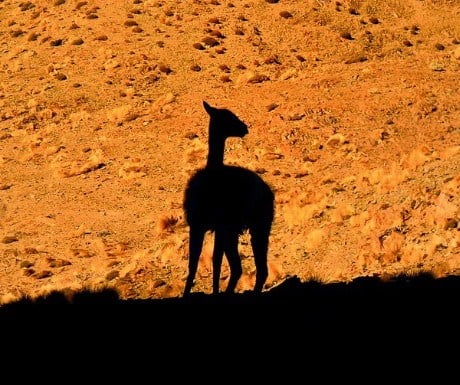 In fact, these South American camelids are the only relatives of the camel in existence today, which raises the question as to how they got to South America? There are several theories about this, though studies on the question remain incomplete. The best-known theory asserts that these animals first appeared in North America some five million years ago. From there, due to the adverse climate resulting from the advance of glaciers, they emigrated over time, some wandering as far as Eurasia, where they in turn evolved into the two species we know today: the two-humped camel and the one-humped dromedary. Other ancestors of todays the Lamini (humpless) species of camelid made their way to South America, crossing the Panama isthmus some three million years ago. The paradox is that, over time, they eventually disappeared from their place of origin, perhaps due to the extreme weather conditions or because of the arrival of a new predator: human beings.
In South America, there are four species of camelids: llamas, alpacas, vicuñas, and guanacos. Llamas and alpacas are domesticated species, while vicuñas and guanacos are found only in the wild. The four share some characteristics, for example their ability to breed with each other and their sexual dimorphism (which means its not easy to distinguish their gender). Alpacas, llamas and vicunas have another common feature: they live in highlands, while guanacos can live at sea level.
Llamas: the sacred animals of the Incas
Among the Andean camelids, the llama is the largest. Its most striking feature is that its not a natural species, as it is a creation of human beings. Specifically, the people of the highlands began domesticating guanacos some 5,000 years ago. The animals geographical distribution is now wide since it became a trade commodity during the Inca Empire. Nonetheless, they are found principally in the Andes of Peru, Bolivia, Chile, Ecuador and Argentina. Llamas have traditionally been used as beasts of burden, though they are also used for their wool and for meat. As their wool is thick and strong, its highly valued particularly because its not chemically treated.
In fact, these South American camelids are the only relatives of the camel in existence today, which raises the question as to how they got to South America? There are several theories about this, though studies on the question remain incomplete. The best-known theory asserts that these animals first appeared in North America some five million years ago. From there, due to the adverse climate resulting from the advance of glaciers, they emigrated over time, some wandering as far as Eurasia, where they in turn evolved into the two species we know today: the two-humped camel and the one-humped dromedary. Other ancestors of todays the Lamini (humpless) species of camelid made their way to South America, crossing the Panama isthmus some three million years ago. The paradox is that, over time, they eventually disappeared from their place of origin, perhaps due to the extreme weather conditions or because of the arrival of a new predator: human beings.
In South America, there are four species of camelids: llamas, alpacas, vicuñas, and guanacos. Llamas and alpacas are domesticated species, while vicuñas and guanacos are found only in the wild. The four share some characteristics, for example their ability to breed with each other and their sexual dimorphism (which means its not easy to distinguish their gender). Alpacas, llamas and vicunas have another common feature: they live in highlands, while guanacos can live at sea level.
Llamas: the sacred animals of the Incas
Among the Andean camelids, the llama is the largest. Its most striking feature is that its not a natural species, as it is a creation of human beings. Specifically, the people of the highlands began domesticating guanacos some 5,000 years ago. The animals geographical distribution is now wide since it became a trade commodity during the Inca Empire. Nonetheless, they are found principally in the Andes of Peru, Bolivia, Chile, Ecuador and Argentina. Llamas have traditionally been used as beasts of burden, though they are also used for their wool and for meat. As their wool is thick and strong, its highly valued particularly because its not chemically treated.
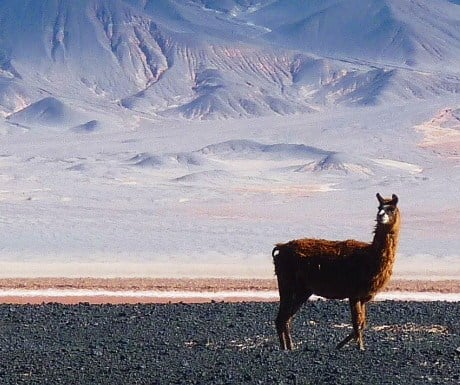 The economy of the Inca Empire was based on the exploitation of llamas, not only for their wool and meat, but also for their bones (used for making musical instruments), their leather (for footwear), their fat (for medicines), and their excrement (for fertilizer).
For the Incas, the llama was a sacred animal. They believed that each llama on Earth had its mirror in the Celestial Llama: a constellation that could be seen from certain sacred places.
The alpaca: an endangered species
The alpaca is a smaller species, though like the llama (and camels) it has the habit of spitting as a method of defense. Alpacas differ from llamas, though, in that they are not used as beasts of burden; however, they have been domesticated for thousands of years as these animals are highly valued for their wool considered the finest among camelids. Alpaca wool is used to make products as diverse as blankets, ponchos, scarves, vests and sweaters, while its meat is considered a delicacy by some peoples of Andes. These camelids stand at between 0.94 and 1.04 meters high and weigh between 50 and 55 kg. They are found mainly in Ecuador, Peru, Bolivia, Chile and Argentina, although countries such as Australia, the USA and New Zealand possess small numbers and are making great efforts to increase their populations.
The economy of the Inca Empire was based on the exploitation of llamas, not only for their wool and meat, but also for their bones (used for making musical instruments), their leather (for footwear), their fat (for medicines), and their excrement (for fertilizer).
For the Incas, the llama was a sacred animal. They believed that each llama on Earth had its mirror in the Celestial Llama: a constellation that could be seen from certain sacred places.
The alpaca: an endangered species
The alpaca is a smaller species, though like the llama (and camels) it has the habit of spitting as a method of defense. Alpacas differ from llamas, though, in that they are not used as beasts of burden; however, they have been domesticated for thousands of years as these animals are highly valued for their wool considered the finest among camelids. Alpaca wool is used to make products as diverse as blankets, ponchos, scarves, vests and sweaters, while its meat is considered a delicacy by some peoples of Andes. These camelids stand at between 0.94 and 1.04 meters high and weigh between 50 and 55 kg. They are found mainly in Ecuador, Peru, Bolivia, Chile and Argentina, although countries such as Australia, the USA and New Zealand possess small numbers and are making great efforts to increase their populations.
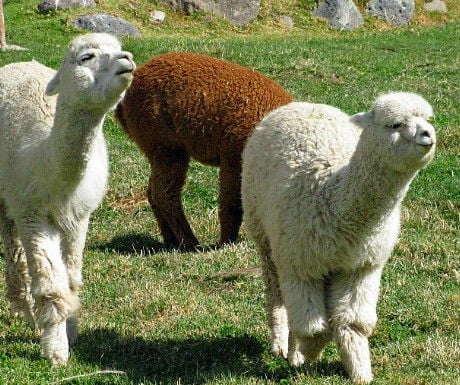 The alpaca is a smaller species, though like the llama (and camels) it has the habit of spitting as a method of defense. Alpacas differ from llamas, though, in that they are not used as beasts of burden; however, they have been domesticated for thousands of years as these animals are highly valued for their wool considered the finest among camelids. Alpaca wool is used to make products as diverse as blankets, ponchos, scarves, vests and sweaters, while its meat is considered a delicacy by some peoples of Andes. These camelids stand at between 0.94 and 1.04 meters high and weigh between 50 and 55 kg. They are found mainly in Ecuador, Peru, Bolivia, Chile and Argentina, although countries such as Australia, the USA and New Zealand possess small numbers and are making great efforts to increase their populations.
The alpaca is a smaller species, though like the llama (and camels) it has the habit of spitting as a method of defense. Alpacas differ from llamas, though, in that they are not used as beasts of burden; however, they have been domesticated for thousands of years as these animals are highly valued for their wool considered the finest among camelids. Alpaca wool is used to make products as diverse as blankets, ponchos, scarves, vests and sweaters, while its meat is considered a delicacy by some peoples of Andes. These camelids stand at between 0.94 and 1.04 meters high and weigh between 50 and 55 kg. They are found mainly in Ecuador, Peru, Bolivia, Chile and Argentina, although countries such as Australia, the USA and New Zealand possess small numbers and are making great efforts to increase their populations.
The vicuña: sedentary and ‘ecological’
The vicuña, a patriotic symbol of Peru, is a smaller herbivorous camelid. Reaching a length of 80 cm and weighing between 40 and 50 kg. These sedentary animals have long legs and, in a sense, are ecological because the soles of their feet have a kind of pad that prevents them from digging up vegetation, in this way not contributing to erosion. In addition, they have a very structured and organized social system: adult males live with a harem of two or three females and their young. The wool of the vicuña is some of the best of its type since, in the world of haute couture, a square meter can cost up to $3,000 USD. High fashion labels, especially Italian and French companies, use vicuña wool for the production of exclusive clothing. However, due to the intense hunting of these animals since ancient times, vicuna are now in danger of extinction. Like alpacas and llamas, they live mainly in Chile, Argentina, Bolivia, Peru and Ecuador.
The alpaca is a smaller species, though like the llama (and camels) it has the habit of spitting as a method of defense. Alpacas differ from llamas, though, in that they are not used as beasts of burden; however, they have been domesticated for thousands of years as these animals are highly valued for their wool considered the finest among camelids. Alpaca wool is used to make products as diverse as blankets, ponchos, scarves, vests and sweaters, while its meat is considered a delicacy by some peoples of Andes. These camelids stand at between 0.94 and 1.04 meters high and weigh between 50 and 55 kg. They are found mainly in Ecuador, Peru, Bolivia, Chile and Argentina, although countries such as Australia, the USA and New Zealand possess small numbers and are making great efforts to increase their populations.
The alpaca is a smaller species, though like the llama (and camels) it has the habit of spitting as a method of defense. Alpacas differ from llamas, though, in that they are not used as beasts of burden; however, they have been domesticated for thousands of years as these animals are highly valued for their wool considered the finest among camelids. Alpaca wool is used to make products as diverse as blankets, ponchos, scarves, vests and sweaters, while its meat is considered a delicacy by some peoples of Andes. These camelids stand at between 0.94 and 1.04 meters high and weigh between 50 and 55 kg. They are found mainly in Ecuador, Peru, Bolivia, Chile and Argentina, although countries such as Australia, the USA and New Zealand possess small numbers and are making great efforts to increase their populations.
The vicuña: sedentary and ‘ecological’
The vicuña, a patriotic symbol of Peru, is a smaller herbivorous camelid. Reaching a length of 80 cm and weighing between 40 and 50 kg. These sedentary animals have long legs and, in a sense, are ecological because the soles of their feet have a kind of pad that prevents them from digging up vegetation, in this way not contributing to erosion. In addition, they have a very structured and organized social system: adult males live with a harem of two or three females and their young. The wool of the vicuña is some of the best of its type since, in the world of haute couture, a square meter can cost up to $3,000 USD. High fashion labels, especially Italian and French companies, use vicuña wool for the production of exclusive clothing. However, due to the intense hunting of these animals since ancient times, vicuna are now in danger of extinction. Like alpacas and llamas, they live mainly in Chile, Argentina, Bolivia, Peru and Ecuador.
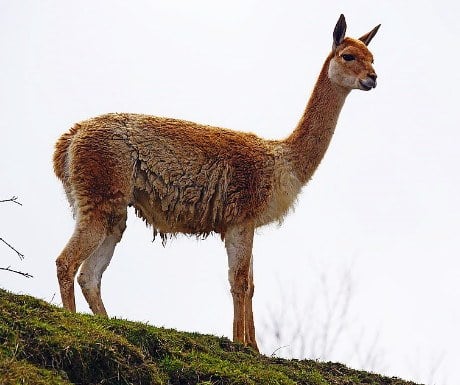 The vicuña, a patriotic symbol of Peru, is a smaller herbivorous camelid. Reaching a length of 80 cm and weighing between 40 and 50 kg. These sedentary animals have long legs and, in a sense, are ecological because the soles of their feet have a kind of pad that prevents them from digging up vegetation, in this way not contributing to erosion. In addition, they have a very structured and organized social system: adult males live with a harem of two or three females and their young. The wool of the vicuña is some of the best of its type since, in the world of haute couture, a square meter can cost up to $3,000 USD. High fashion labels, especially Italian and French companies, use vicuña wool for the production of exclusive clothing. However, due to the intense hunting of these animals since ancient times, vicuna are now in danger of extinction. Like alpacas and llamas, they live mainly in Chile, Argentina, Bolivia, Peru and Ecuador.
The elegant guanaco
Elegant, possessing fine bones, and a fast runner (reaching up to 64 km per hour), the guanaco is also a threatened species of camelid, even scarcer than llamas. The animal is sociable, especially when young, though later they become more aloof in relation to humans, as they roam in large herds in semi-desert areas. They have thick and soft coats that protect them from the cold, which is helpful in that they live mainly in Peru, Chile, Bolivia and Argentina. Guanacos can weigh up to 140 kg and measure 1.70 m in height. Their coats are of three shades: beige on the upper body, white on their stomach areas and gray on their heads. Their wool and leather are used to make fine and highly valued garments.
The vicuña, a patriotic symbol of Peru, is a smaller herbivorous camelid. Reaching a length of 80 cm and weighing between 40 and 50 kg. These sedentary animals have long legs and, in a sense, are ecological because the soles of their feet have a kind of pad that prevents them from digging up vegetation, in this way not contributing to erosion. In addition, they have a very structured and organized social system: adult males live with a harem of two or three females and their young. The wool of the vicuña is some of the best of its type since, in the world of haute couture, a square meter can cost up to $3,000 USD. High fashion labels, especially Italian and French companies, use vicuña wool for the production of exclusive clothing. However, due to the intense hunting of these animals since ancient times, vicuna are now in danger of extinction. Like alpacas and llamas, they live mainly in Chile, Argentina, Bolivia, Peru and Ecuador.
The elegant guanaco
Elegant, possessing fine bones, and a fast runner (reaching up to 64 km per hour), the guanaco is also a threatened species of camelid, even scarcer than llamas. The animal is sociable, especially when young, though later they become more aloof in relation to humans, as they roam in large herds in semi-desert areas. They have thick and soft coats that protect them from the cold, which is helpful in that they live mainly in Peru, Chile, Bolivia and Argentina. Guanacos can weigh up to 140 kg and measure 1.70 m in height. Their coats are of three shades: beige on the upper body, white on their stomach areas and gray on their heads. Their wool and leather are used to make fine and highly valued garments.
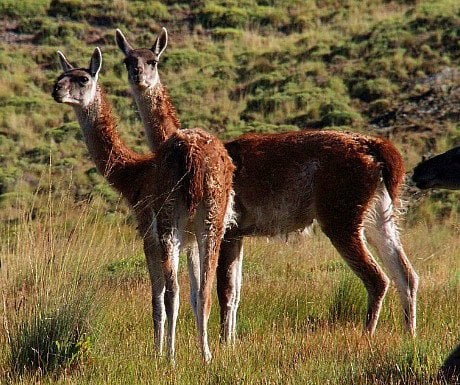 Camelids: the camels of the New World
These four species of South American camelids are called the camels of the New World. Like their humpbacked relatives in Asia and Africa, they have certain characteristics that have allowed them to adapt to arid regions, while they themselves also serve as important resources for the populations with whom they coexist. According to several studies, of the 9 million camelids in South America, many alpacas and llamas still serve as the main source of income for certain farm communities of the region.
Camelids: the camels of the New World
These four species of South American camelids are called the camels of the New World. Like their humpbacked relatives in Asia and Africa, they have certain characteristics that have allowed them to adapt to arid regions, while they themselves also serve as important resources for the populations with whom they coexist. According to several studies, of the 9 million camelids in South America, many alpacas and llamas still serve as the main source of income for certain farm communities of the region.
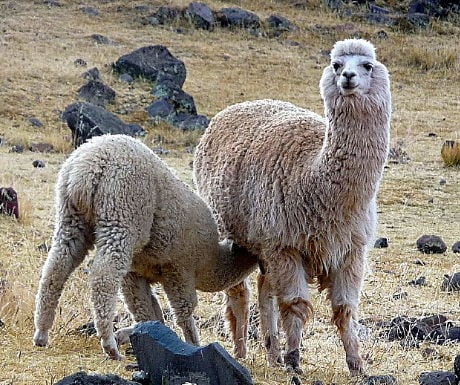 They are, without a doubt, curious and interesting animals. Those who study them describe them as diurnal and social, although if they get angry, they release a secretion of mucus through their nose not aggressively, but rather to defend themselves when they feel threatened.
But in addition to their historical role in providing meat and wool to Andean peoples, certain camelids are currently used for novel therapies. What is known as alpaca-therapy or lama-therapy has been developed in Germany as a variation of the treatments that use dogs, horses and dolphins. It is claimed that children with autism, people who have suffered traumatic experiences, those afflicted with high levels of stress, and people with psychiatric problems can all benefit from this treatment. This approach is based on a unique characteristic of camelids: they are said to be the only animals that really look into the eyes and observe humans, as they are sensitive, curious and project a calming presence. As they are also docile and serene which add to their beauty and magnetism they exert a kind of fascination by those who look at them.
In short, there is much to discover about these animals. When traveling through the Andes, its worth seeing them close up in the landscapes in which they reign. Look into their eyes and find out if it is true that they can peer into your being. But of course, for your sake, be very careful not to disturb them…
Alfonso Tandazo is President and CEO at Surtrek Tour Operator.
If you would like to be a guest blogger on A Luxury Travel Blog in order to raise your profile, please contact us.
They are, without a doubt, curious and interesting animals. Those who study them describe them as diurnal and social, although if they get angry, they release a secretion of mucus through their nose not aggressively, but rather to defend themselves when they feel threatened.
But in addition to their historical role in providing meat and wool to Andean peoples, certain camelids are currently used for novel therapies. What is known as alpaca-therapy or lama-therapy has been developed in Germany as a variation of the treatments that use dogs, horses and dolphins. It is claimed that children with autism, people who have suffered traumatic experiences, those afflicted with high levels of stress, and people with psychiatric problems can all benefit from this treatment. This approach is based on a unique characteristic of camelids: they are said to be the only animals that really look into the eyes and observe humans, as they are sensitive, curious and project a calming presence. As they are also docile and serene which add to their beauty and magnetism they exert a kind of fascination by those who look at them.
In short, there is much to discover about these animals. When traveling through the Andes, its worth seeing them close up in the landscapes in which they reign. Look into their eyes and find out if it is true that they can peer into your being. But of course, for your sake, be very careful not to disturb them…
Alfonso Tandazo is President and CEO at Surtrek Tour Operator.
If you would like to be a guest blogger on A Luxury Travel Blog in order to raise your profile, please contact us.Did you enjoy this article?
Receive similar content direct to your inbox.



Very informative. I’ve always loved alpacas soo much, they’re so gentle and cute. Llamas are slightly scarier to me lol! Definitely going to pass on these facts to my partner, he’d definitely be interested. I’ve never even heard of vicuñas, and guanacos before.